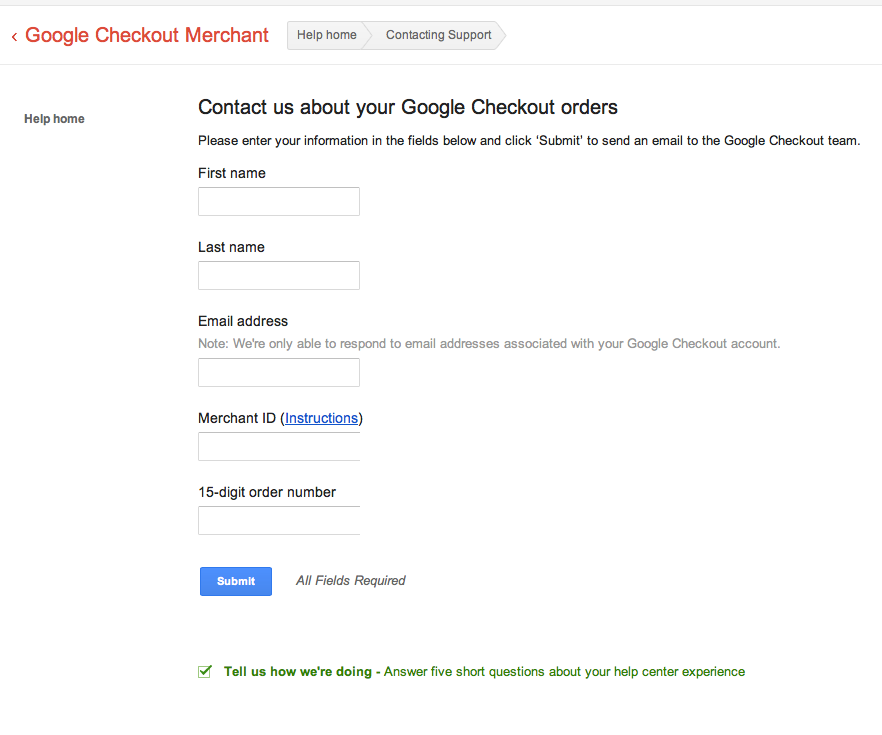Last week, we felt that it was prudent to disable the use of Google Checkout from our site, WeaKnees.com. I’m writing this post to explain why we did so, and why it was hard.
Explaining why it was hard is the easy part. What business wants to turn away potential customers? In general, the mantra of any online business is to accept customers’ money in the easiest way possible. Generally, that means offering a variety of payment methods, so a customer can feel comfortable with that choice, choose the one they prefer, and potentially take advantage of having an existing shortcut set up with that provider – as is the case with PayPal and Google Checkout.
But we felt that the current problems with Google Checkout merited actually reducing our payment options by one.
On to the events. Last week, for some reason we still don’t understand, Google Checkout’s risk analysis started failing on each of our orders, at least in part. While it’s still a bit confusing to us, Google offers a few ways to gauge whether an order is likely legitimate or fraudulent. And, on one measure, they’ll basically guarantee that it’s legitimate. Unfortunately, for online businesses, fraud is a common enough issue that we have to always be watchful.
So last week, Google started sending through XML for new orders with this line:
<eligible-for-protection>false</eligible-for-protection>
Literally, every order started to come through that way. We’ve had orders with that flag before, and we weigh the information we have when deciding whether we should complete the order. But maybe one in a hundred had that. Now, all were coming that way.
We decided to double-check this information with the information presented in the Google Checkout control panel on the web, and for these same orders we routinely read:
The customer’s credit card was authorized for $xx.xx, and passed all risk checks.
At this point, we knew we needed to contact Google. We dug around for a phone number, or even an email address, and there was nothing but an online form we could fill out for assistance. While we found that alone to be annoying, what irritated us even more was that the form didn’t allow space to explain the issue – only to enter an order number. I’m really not sure how that helps get the situation resolved, but that’s all they allow. Here’s the form:

This page is located here.
As you can see, there is no way to explain the issue. This was a great prelude of what was to come.
We did eventually get an email back and we started a correspondence about the problem. While I was certain we’d hear “yes, we’re experiencing technical issues with our fraud guarantee algorithm, please wait while we sort this out” I heard nothing even close.
Here’s what I heard:
Hello Michael,
Thanks for your email.
We’d be happy to answer any questions you may have about Google Checkout order #XXXXXXXXXXXXX, but we ask that you reply with more specific details so that we can clarify your concerns and better assist you.
If you have additional questions, please visit our Help Center at http://checkout.google.com/support/sell/
Hmm. More specific details. I would have loved to provide those initially, of course.
So I did reply. With specifics. Here’s the bland response I got back:
Hello Michael,
Thanks for your email.
An order’s eligibility for the Payment Guarantee is based on complex, proprietary fraud detection technology. While we can’t disclose the exact reason why a particular order may or may not be eligible for the Payment Guarantee, please know that many factors go into determining an order’s eligibility.
Ineligible orders aren’t necessarily fraudulent. Since you know your business best, you’re welcome to process them at your own discretion.
To view the full details of the Google Checkout Payment Guarantee policy, see https://checkout.google.com/support/sell/bin/answer.py?answer=42863
At this point, I went into a lengthier email trying to get this Google representative to stop with the canned responses and to try to understand that something out of the ordinary was happening here. No such luck. The wall was up, and it wasn’t coming down. Here’s the final response I was able to elicit:
Hello Michael,
Thanks for your response. Currently we don’t offer phone support at this time. Please accept our apologies for the inconvenience this may have caused.
Thanks for notifying us about this issue. Our engineering team is currently investigating the issue, and will keep you posted with any new updates.
In the meantime, please feel free to contact us if you have additional questions. We appreciate your patience and apologize for any inconvenience this may have caused.
If you have additional questions, please visit our Help Center at http://checkout.google.com/support/sell/
There is the hint that “Our engineering team is currently investigating the issue” but I pushed further on that and wasn’t even given the courtesy of a reply.
Now, I understand that Google has become a huge company, and that they can’t offer phone support to users, or even provide account contacts. But I do think that this situation is different from many interactions with Google for a few reasons:
- This is a product we PAY for. This isn’t a free service or an ad-supported service or a service meant to gather eyeballs for potential later monetization. It was those things originally, but it’s now into the mature money-making stage.
- While we’re certainly a small player to Google Checkout, I would hope they could give us a little credence as a knowledgeable company regarding their product. We were beta testers of the product, and they even wrote a case study about us when the service launched publicly.
- They position this product as a competitor to PayPal largely, even down to copying the exact fee structure that PayPal has. Here is Google’s and here is PayPal’s. But PayPal offers its merchants phone support in the event of problems. We’ve used it. They’re genuinely helpful. I feel strange recommending PayPal over a Google product, but having experience with both parties, PayPal is the clear winner.
One thought we had was, considering that our rate of fraud has been extremely low with Google, we could use the information that they provide merchants to evaluate on our own. They do give us good information, such as the AVS match of the credit card, and the CVV match status, and even the age of the Google Checkout account. I’m sure other merchants will do the same and just accept orders that look OK but that Google can’t stand behind. But I’m too worried that some scam artist will discover the issue and exploit it. If merchants let their guard down and allow orders to pass through with these characteristics, then scammers will come in and create fraudulent orders.
There are plenty of other quirks and problems with Google Checkout – they combine batch deposits with seemingly no rhyme or reason and certainly no explanation, they don’t allow for a customer ‘notes’ section to communicate additional information about an order, they basically won’t represent a seller in the case of a dispute, etc. – but those all seemed like problems we could accept. Every payment method has some issues. But a lack of help with a legitimate problem – that’s too much. We had to vote with our feet and with our wallet, and so, while we’re sorry to say it, we just can’t accept Google Checkout orders at this time.


